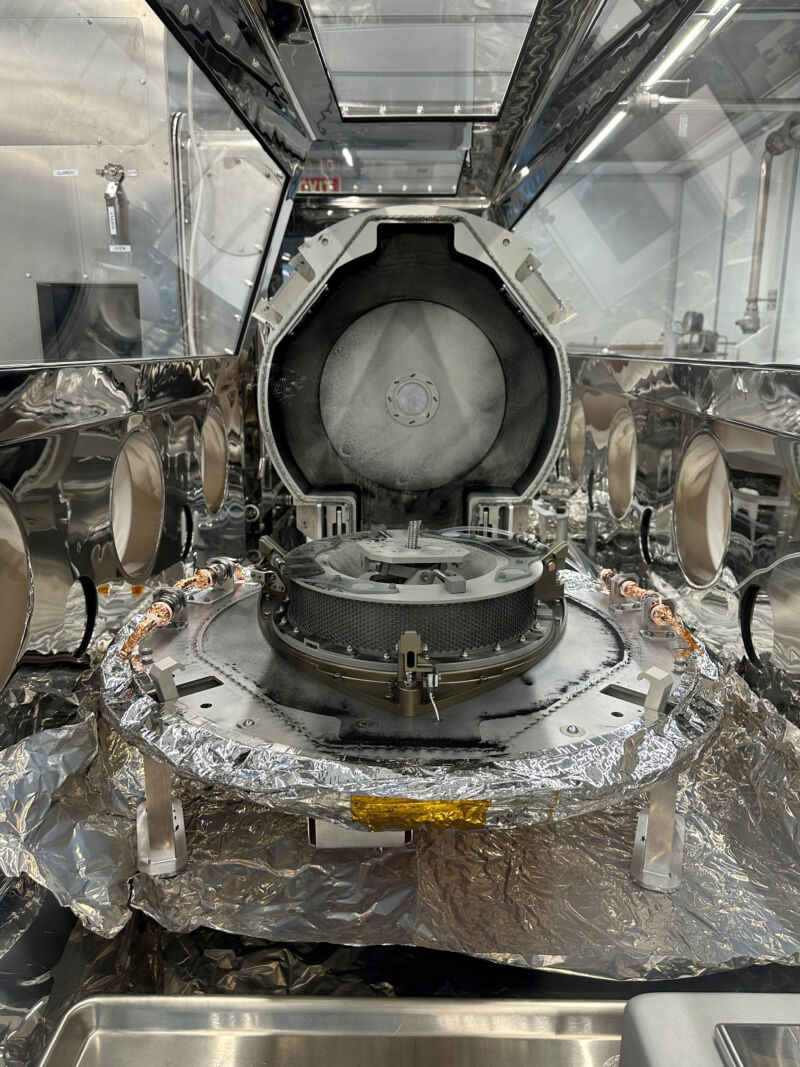
Dante Lauretta, a planetary scientist at the University of Arizona, has waited nearly 20 years to get his hands on pristine specimens from an asteroid, which he says is a key to unlocking answers to mysteries about the origin of life on Earth. On Tuesday, he got his first look at dust grains returned by NASA's OSIRIS-REx mission.
Because they want to be sure, members of the OSIRIS-REx science team will wipe some of the dust from the asteroid sample canister and send it to a laboratory for analysis. But there's little question the dust grains visible immediately after scientists opened the lid to the canister are from asteroid Bennu, where the OSIRIS-REx spacecraft captured rocks during a touch-and-go landing in 2020.
The spacecraft completed its round-trip journey to asteroid Bennu with a near-bullseye landing of its sample return capsule Sunday morning in Utah. The OSIRIS-REx (Origins, Spectral Interpretation, Resource Identification, Security-Regolith Explorer) mothership released the capsule to plunge into the atmosphere while it fired its thrusters to maneuver on a trajectory to head back into the Solar System for an extended mission to visit another asteroid.
Ground teams quickly retrieved the capsule and shipped it from Utah to NASA's Johnson Space Center in Houston on Monday on a US Air Force cargo plane. It then traveled to a specially built super-clean curation facility at the space center, which is also home to the collection of Moon rocks brought back on NASA's Apollo missions more than 50 years ago.
The sample canister was then placed inside a glovebox to allow scientists to work with the hardware through gloved ports. Then came the moment Tuesday when scientists opened the lid.
“We opened up the canister today, and we did see that there is some black dust-like material that's visible," Lauretta said Tuesday. "We're hoping that's from Bennu. We expect that we'll be collecting a portion of that tomorrow morning, and that'll go right into laboratories."
"This is our first glimpse of what we might have," said Lauretta, the OSIRIS-REx mission's principal investigator. "There's good indication that we might have sample."
Tip of the iceberg
When the spacecraft departed the roughly 1,600-foot-wide (500-meter) asteroid Bennu in 2020, engineers estimated the probe had gathered around 250 grams, or 8.8 ounces, of specimens from Bennu's porous surface. The spacecraft sampled the asteroid by extending a robotic arm out in front of it, then essentially pogoing off the surface, only contacting Bennu for a few seconds. When it touched the asteroid, the spacecraft released a burst of gas to funnel loose rocks into a collection chamber shaped like an air filter on the end of the robot arm. This device is called the Touch-and-Go Sample Acquisition Mechanism, or TAGSAM.
Scientists discovered the collection chamber's door was wedged open with larger rocky material, with some fragments of rock leaking out into space, so they decided to quickly stow the sampling device inside the return capsule to avoid losing more material. That led some scientists on the OSIRIS-REx team to wonder whether the spacecraft might come back to Earth with even more than the 250-gram estimate, which was four times the minimum requirement for mission success.
Researchers likely won't know for sure how much material OSIRIS-REx brought home until next month. That will require the lab team in Houston to remove the TAGSAM sampling mechanism from its restraint inside the canister, which protected it for the journey back to Earth like a nested doll. Then they will open up the device and hopefully find larger chunks of rock. All of this should happen in the next couple of weeks.
But the first glimpse at the inside of the sample canister looks promising.

"By Friday, we should have a pretty good sense of what the quick-look analysis is telling us (about the dust)," Lauretta said. "First of all, do we, in fact, have asteroid dust? That's the first thing. Is it the kind of material that we expected, based on the remote sensing that we did at the asteroid? And how does that feed into our sample analysis plan, which we've been writing over the past two years in great detail?
"That's just the dust that we can visibly see right now. The real treasure is inside TAGSAM, which we're not going to get access to until probably late next week, and that is going to be a very deliberative process to figure out what is the nature of that collection, and how do we fairly distribute it to our international partners, to the science team for OSIRIS-REx, and also preserve the long-term integrity for future researchers."
NASA will set aside about 70 percent of the asteroid sample to be analyzed decades in the future by scientists equipped with new lab technology and techniques. NASA has scheduled a press conference for October 11 to reveal more details about the nature of the sample from Bennu.
"I'm thrilled here because this is the moment we've been dreaming of," Lauretta said. "We can see the thing that touched Bennu is now in our laboratories. Of course, we can't wait to get inside. We’ve still got a lot of work to do. We still gotta get inside that TAGSAM. That's where the real treasure is, but we know how to do that and the team is ready and raring to go."



3175x175(CURRENT).thumb.jpg.b05acc060982b36f5891ba728e6d953c.jpg)
Recommended Comments
There are no comments to display.
Join the conversation
You can post now and register later. If you have an account, sign in now to post with your account.
Note: Your post will require moderator approval before it will be visible.